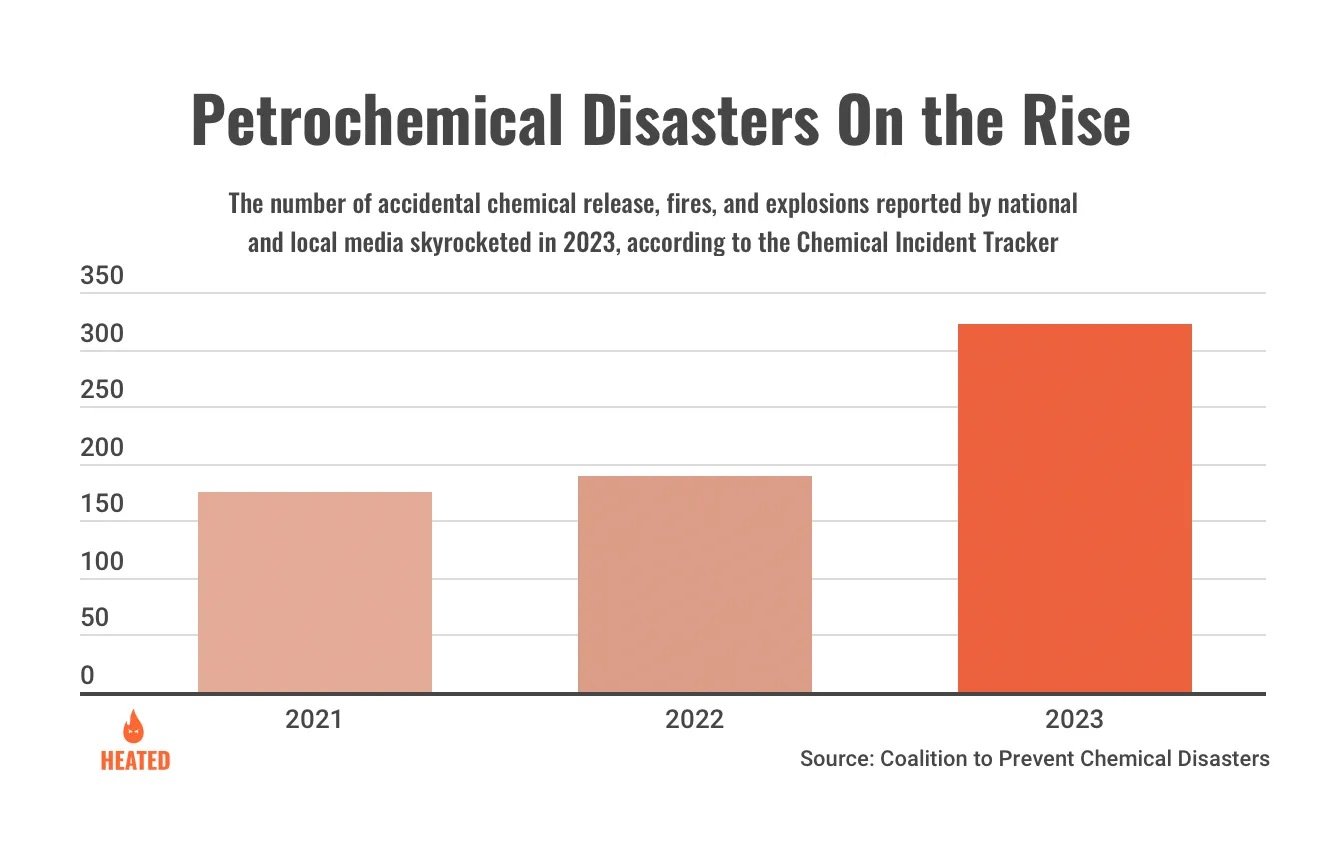A chemical disaster occurred almost every day in 2023



A plume of smoke rises over East Palestine, Ohio, after a freight train containing toxic petrochemicals derailed there in February 2023. The smoke is from a controlled detonation of the chemicals. Source: Gene J. Puskar/AP
Petrochemical incidents aren't always as visible as the East Palestine train derailment, but at least 322 happened last year.
by EMILY ATKIN
Climate policy obstructionists love to evangelize about the benefits of petrochemicals.
Last year, in commercials and Congressional hearings alike, the fossil fuel industry and its political allies upped their messaging around the chemical byproducts of oil and gas, calling petrochemicals “essential to life,” and warning it would be dangerous to phase them out or transition to greener alternatives.
What proponents consistently did not mention, however, was that petrochemicals were leaking, exploding, and catching fire all over the country last year, causing disastrous consequences multiple times per week.
There were at least 322 hazardous chemical incidents in the U.S. in 2023, according to the Chemical Incident Tracker, a database of media-reported accidental chemical releases compiled by the Coalition to Prevent Chemical Disasters. That’s around a 70 percent increase in media-reported chemical incidents since 2022, when the coalition recorded only 189 disasters.
Out of the 322 chemical incidents reported last year, 138 caused either injury, evacuation, a shelter-in-place order, or death, according to the database. Put another way, a chemical incident caused serious consequences in the U.S. about once every two-and-a-half days in 2023.
The majority of last year’s chemical incidents involved fossil fuels and fossil fuel-derived products. At least 47 incidents occurred directly at oil and gas extraction sites, while 83 incidents occurred at plastic and petrochemical manufacturing sites, according to the database. At least 48 chemical incidents occurred in transport, like the infamous East Palestine, Ohio train derailment, which spilled the petrochemical vinyl chloride. And at least 39 chemical incidents occurred at food and beverage storage facilities, most of which involved leakage of ammonia, a particularly toxic petrochemical that is responsible for about 1 to 2 percent of global carbon emissions.
At least 18 people died last year in chemical incidents. Lives claimed by petrochemical disasters in 2023 include a 25-year-old Illinois wrestling coach who was killed by an asphalt tank explosion; an Illinois father and his two young children who were killed by ammonia exposure after a semitruck derailed; and a 55-year-old father who was “burned alive” after a “petrochemical event” at the Marathon Petroleum refinery he worked at, according to a lawsuit filed by his family.
The data is important, activists say, because the petrochemical and chemical industries regularly downplay the harm their products inflict on communities. “The chemical industry consistently claims that incidents at hazardous facilities are isolated events,” said Deidre Nelms, the communications manager at environmental justice nonprofit Coming Clean, which helps manage the database. “But our data show that fires, explosions and releases involving hazardous chemicals are happening on a near daily basis.”
Still, the number of chemical incidents recorded by the Chemical Incident Tracker is almost certainly an underestimate, as it contains only disasters reported by national and local media. The coalition tracks incidents this way because publicly-available government data of chemical incidents in the U.S. is “very delayed, limited, and hard to find,” Nelms said—in part because each state has different reporting systems and requirements.
It is possible, then, that the increased number of chemical incidents in 2023 also reflects increased media attention to the issue. That would make sense, given the massive virality of the East Palestine, Ohio train derailment story in early 2023. Perhaps, in light of that story, more news editors across the country began to see that chemical incidents aren’t just newsworthy on their own—they also drive clicks, ratings, and engagement.


